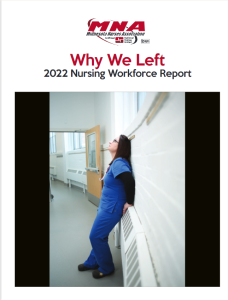FOR IMMEDIATE RELEASE
Contact: Sam Fettig
(o) 651-414-2863
(c) 612-741-0662
sam.fettig@mnnurses.org
Lauren Nielsen
(o) 651-414-2862
(c) 651-376-9709
lauren.nielsen@mnnurses.org
(St. Paul) – March 31, 2022 – Minnesota nurses released a new report today – “Why We Left: 2022 Nursing Workforce Report” – which identifies poor hospital management and chronic short staffing as the top issues driving nurses away from bedside care. In a roundtable discussion at the State Capitol today, nurses who retired early or left full-time bedside care positions shared stories of their experiences, including why they left and what it would have taken for them to stay.
today, nurses who retired early or left full-time bedside care positions shared stories of their experiences, including why they left and what it would have taken for them to stay.
WATCH: Click here to watch the roundtable discussion with nurses who left the bedside.
The report released today was compiled by the Minnesota Nurses Association based on a survey of 748 nurses who left an MNA-represented nursing job in the past two years and did not take a new job in another MNA-represented facility. The survey focused on why nurses left their hospital job, what they are doing now, and whether they plan to return to bedside care under the current conditions in Minnesota hospitals.
One long-term nurse cited her reason for leaving the bedside as, in part: “Bad management with COVID – told me to spend ‘least amount of time with patients as possible!’ […] After 34 years of faithful nursing at that hospital, I left crying after every shift the last 4 months.”
Responding nurses overwhelmingly cited concerns with poor hospital management and chronic under-staffing as the top drivers of their departure. Overall, 262 nurses cited management issues and 120 cited short staffing as key contributing factors to their decision to leave the bedside. These responses dwarfed concerns specific to the COVID-19 pandemic or to so-called nurse “burnout.”
In the survey, another nurse responded that she left the bedside because it “Didn’t feel supportive as a new grad nurse. I was a brand-new nurse working in the hospital during COVID, and I was very overwhelmed and underappreciated.”
Of those nurses who did identify the pandemic as a contributing factor in their decision to leave the bedside, nearly 40 percent also cited management concerns. Similarly, among those who identified stress or so-called burnout, 40 percent also cited poor hospital management and 26 percent cited persistent short staffing issues. Just 20 nurses out of 748 cited COVID-19 vaccine requirements as contributing to their decision to leave the bedside.
Nurses described the feeling of being driven away from the bedside despite their desire to stay, including one experienced nurse who cited “Ongoing short staffing issues, risk of my license, management not caring about subpar patient care or the risk of patient harm due to staffing. Lack of support and/or respect by some nursing supervisors, social work, and other charge nurses […] It broke my heart to have to leave there.”
Another recent survey of MNA nurses indicated that, despite the challenges nurses are currently experiencing on the job, more than 75 percent of nurses want to stay at the bedside for the near future. However, of nurses who left in the last two years, 84 percent say they would not return to bedside care while conditions in Minnesota hospitals remain unchanged. These results make clear what Minnesota nurses have been saying: that there is no shortage of nurses in Minnesota who want to care for patients, but there is a crisis of retention which has been created by hospital CEOs, pushing nurses away from the bedside.
The new study underscores the need for solutions to the understaffing and retention crisis in our hospitals. MNA nurses have proposed a solution with the Keeping Nurses at the Bedside Act, which would establish local, hospital-based committees of nurses and managers to set staffing levels together on a unit-by-unit basis. The bill would also fund grants to support mental health and loan forgiveness programs for nurses. The bill has the support of Governor Tim Walz, the House Majority Caucus and the Senate Minority Caucus, and has been laid over for possible inclusion in the House Health Omnibus Bill.
Other highlights of the new report include:
- Minnesotans understand the nature of the staffing and retention crisis, as 85 percent believe it will not be solved without direct action, and two-thirds understand that hospital executives created the problem before the pandemic.
- There is no shortage of registered nurses in Minnesota, as studies and reports by the Minnesota Hospital Association, the U.S. Department of Health and Human Services, and the Minnesota Board of Nursing clearly demonstrate.
- In 2021, 63 percent of MNA nurses reported that they had considered leaving their job or the profession altogether, or that they knew someone who had, due to being overworked, understaffed, and demoralized about the quality of patient care they could provide.
- In over 80 percent of cases where nurses filed a concern over the impact of short staffing on patient care, the nurses reported no response or inadequate action from hospital management.
- In a survey of MNA nurses who left their bedside nursing positions, the top-cited reasons for their departure were hospital management and chronic short-staffing.
- Despite the pandemic, over 75 percent of MNA members indicated their desire to stay at the bedside for the near future; of nurses who left the bedside in the last two years, 84 percent indicated that they would not return to the bedside if conditions did not improve.
CLICK HERE to read the full report, including additional data and quoted survey responses.
###

